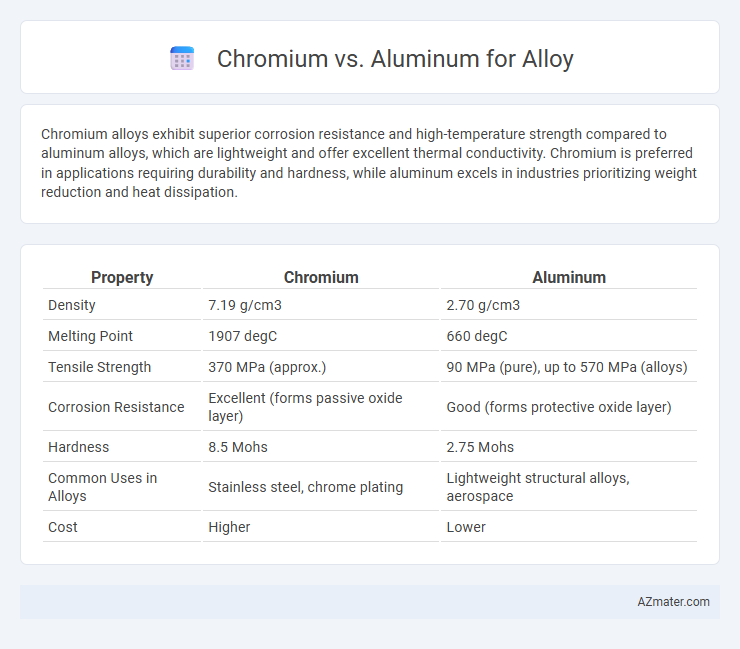Chromium alloys exhibit superior corrosion resistance and high-temperature strength compared to aluminum alloys, which are lightweight and offer excellent thermal conductivity. Chromium is preferred in applications requiring durability and hardness, while aluminum excels in industries prioritizing weight reduction and heat dissipation.
Table of Comparison
| Property | Chromium | Aluminum |
|---|---|---|
| Density | 7.19 g/cm3 | 2.70 g/cm3 |
| Melting Point | 1907 degC | 660 degC |
| Tensile Strength | 370 MPa (approx.) | 90 MPa (pure), up to 570 MPa (alloys) |
| Corrosion Resistance | Excellent (forms passive oxide layer) | Good (forms protective oxide layer) |
| Hardness | 8.5 Mohs | 2.75 Mohs |
| Common Uses in Alloys | Stainless steel, chrome plating | Lightweight structural alloys, aerospace |
| Cost | Higher | Lower |
Introduction to Chromium and Aluminum Alloys
Chromium and aluminum alloys are widely used in various industries due to their unique properties; chromium enhances corrosion resistance and hardness when added to steel, creating stainless steel alloys that excel in durability and environmental resistance. Aluminum alloys, known for their lightweight and excellent strength-to-weight ratio, are essential in aerospace and automotive sectors, offering high thermal and electrical conductivity alongside good corrosion resistance. The distinct metallurgical characteristics of chromium and aluminum alloys make them critical materials for structural, mechanical, and chemical applications.
Chemical Properties and Alloy Composition
Chromium enhances corrosion resistance and hardness when added to aluminum alloys, creating materials with improved oxidation resistance and durability in harsh environments. Aluminum-chromium alloys typically contain 0.5% to 10% chromium by weight, which stabilizes the alloy's microstructure and increases tensile strength without significantly adding weight. The chemical properties of chromium, such as its high melting point and ability to form a passive oxide layer, contribute to the enhanced chemical stability and wear resistance of aluminum alloys used in aerospace and automotive applications.
Strength and Durability Comparison
Chromium alloys exhibit superior strength and corrosion resistance compared to aluminum alloys, making them ideal for high-stress applications requiring durability. Aluminum alloys offer excellent strength-to-weight ratios and corrosion resistance but generally fall short of chromium in hardness and wear resistance. The choice between chromium and aluminum alloys depends largely on specific performance requirements, balancing toughness and lightweight properties.
Corrosion Resistance Differences
Chromium significantly enhances the corrosion resistance of alloys by forming a stable, passive oxide layer that prevents further surface degradation. Aluminum also exhibits excellent corrosion resistance due to its natural oxide film, but chromium alloys typically outperform aluminum in aggressive environments such as acidic or chloride-rich conditions. The presence of chromium increases resistance to rust and pitting, making chromium-containing alloys preferable for applications requiring robust and long-lasting corrosion protection.
Weight and Density Analysis
Chromium alloys typically exhibit higher density, around 7.19 g/cm3, compared to aluminum alloys, which range from 2.6 to 2.8 g/cm3, making aluminum significantly lighter. The lower weight of aluminum alloys enhances fuel efficiency and ease of handling in aerospace and automotive applications. Chromium's greater density contributes to improved strength and corrosion resistance but results in heavier components unsuitable for weight-sensitive designs.
Thermal Conductivity and Heat Resistance
Chromium alloys typically offer lower thermal conductivity compared to aluminum alloys, making them better suited for applications requiring minimal heat transfer. Aluminum alloys exhibit superior thermal conductivity, often exceeding 200 W/m*K, which enhances heat dissipation in heat exchangers and electronic components. In terms of heat resistance, chromium alloys maintain structural integrity at higher temperatures, often above 900degC, whereas aluminum alloys generally have melting points around 660degC, limiting their use in extreme heat environments.
Cost and Availability of Chromium vs Aluminum
Chromium is generally more expensive and less abundant than aluminum, influencing alloy costs significantly. Aluminum's widespread availability and lower extraction costs make it a cost-effective choice for large-scale alloy production. Chromium's higher cost is justified by its superior corrosion resistance and hardness, but limited supply can impact pricing and availability in alloy formulations.
Common Applications in Industry
Chromium alloys are widely used in industries requiring enhanced corrosion resistance and hardness, such as stainless steel production for automotive parts, construction, and aerospace components. Aluminum alloys dominate sectors prioritizing lightweight and high strength-to-weight ratio, including aerospace, transportation, packaging, and consumer electronics. Both metals play crucial roles in manufacturing, with chromium alloy applications focusing on durability and aluminum alloys excelling in lightweight structural components.
Environmental Impact and Sustainability
Chromium alloys offer enhanced corrosion resistance and durability, which often extends product lifespan and reduces the frequency of replacement, contributing positively to sustainability. Aluminum alloys are lightweight and highly recyclable, requiring less energy in recycling processes compared to extracting raw materials, making them favorable in reducing environmental footprint. Both materials have unique environmental trade-offs, but aluminum's high recyclability and lower production emissions generally position it as more sustainable in alloy applications.
Choosing the Right Alloy: Chromium or Aluminum?
Chromium alloys offer superior hardness, corrosion resistance, and wear durability, making them ideal for applications requiring high strength and prolonged exposure to harsh environments. Aluminum alloys provide lightweight properties, excellent thermal conductivity, and good corrosion resistance, preferred in aerospace and automotive industries where weight reduction is critical. Selecting between chromium and aluminum alloys depends on balancing the need for strength and durability versus weight efficiency and conductivity.

Infographic: Chromium vs Aluminum for Alloy
 azmater.com
azmater.com